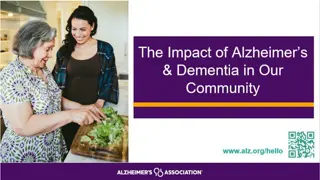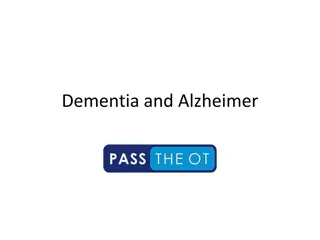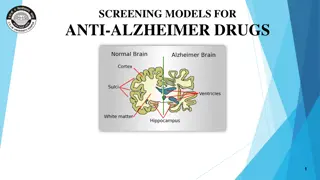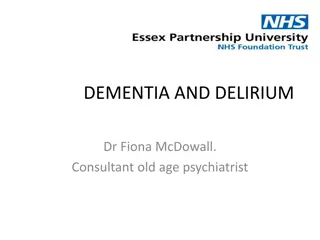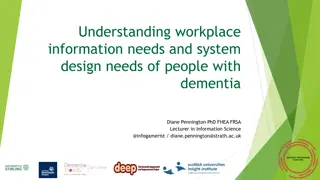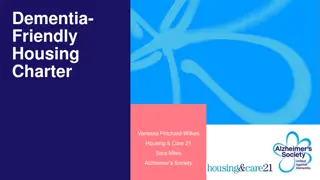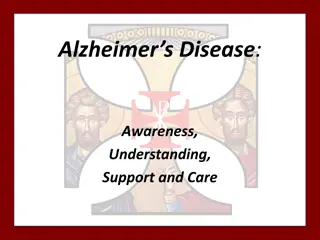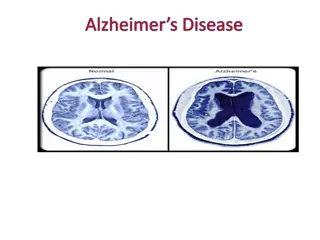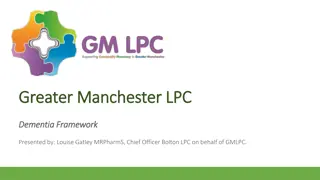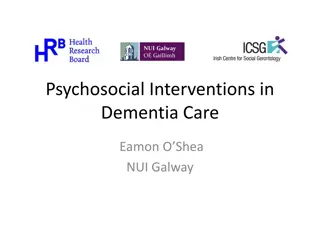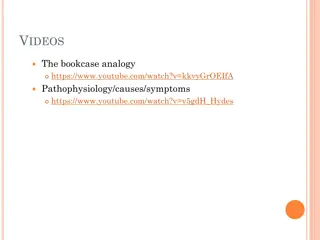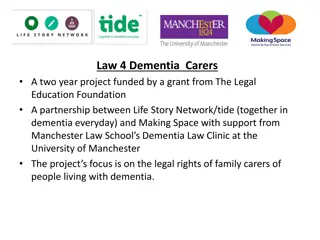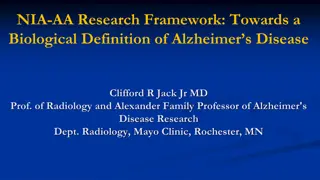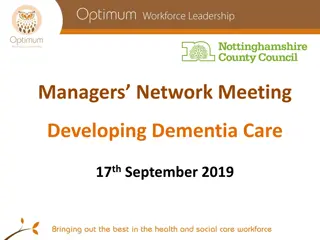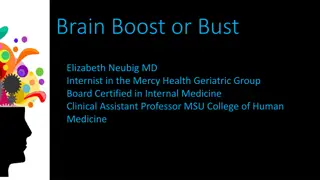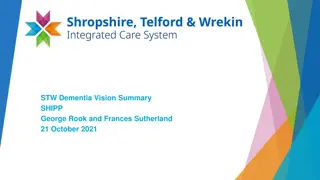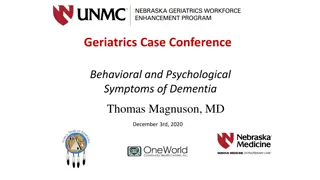Understanding Dementia and Alzheimer's Disease Management
Dementia and Alzheimer's Disease are significant health challenges with under-diagnosis and under-treatment issues. The prevalence of Alzheimer's is high, leading to a substantial societal cost. The natural history of Alzheimer's shows a progression of symptoms over time, with cholinergic dysfunction playing a role. Recognizing the risk factors like age, family history, and educational level is crucial in managing these conditions effectively.
Download Presentation

Please find below an Image/Link to download the presentation.
The content on the website is provided AS IS for your information and personal use only. It may not be sold, licensed, or shared on other websites without obtaining consent from the author. Download presentation by click this link. If you encounter any issues during the download, it is possible that the publisher has removed the file from their server.
E N D
Presentation Transcript
Aspects of Dementia & its management Kunle Ashaye Consultant Psychiatrist & Hon. Senior Lecturer Lister Hospital Stevenage
Alzheimers Disease is under-diagnosed, under-treated, and its cost to society is immense G7 5C 8.3 MM Prevalence* Diagnosed Treated 4.5 MM 48 % 3.0 MM 50 %** 21 % 48 % 25 %** 0.84 MM 35 % 8% 50 % Prevalence Growth Rate Per Year 1.8% 1.6% 4.7% 2.1% *Does not include DLB, Mixed, Vascular Dementia or MCI ** % of patients *** Cognos, April 2000 1998 data from Cognos, April 2000 Calculated Cost to Society
Dementia Dementia Definition: acquired syndrome of decline in memory and other cognitive functions sufficient to affect daily life in an alert patient
Prevalence of Alzheimers disease 60 50% 50 Prevalence (%) 40 30% 30 16% 20 8% 4% 10 2% 1% 0 60-64 65-69 70-74 75-79 80-84 85+ 95+ Age (years) Kurz A. Eur J Neurol 1998; 5(Suppl 4): S1-8 Wimo A et al. Int J Geriatr Psychiatry 1997; 12: 841-56
Natural history of Alzheimers disease Severe Early diagnosis Mild-to-moderate Mini-Mental State Examination (MMSE) 30 Symptoms 25 Diagnosis 20 Loss of functional independence 15 Behavioural problems 10 Nursing home placement 5 Death 0 1 2 3 4 5 6 7 8 9 Time (years) Feldman and Gracon. The Natural History of Alzheimer s Disease. London: Martin Dunitz, 1996
Gross atrophy thinning of gyri widened sulci compare frontotemporal to posterior regions
Plaques and tangles Plaque s and tangles senile plaque and neurofibrillary degeneration (silver impregnation)
Cholinergic dysfunction in AD Cholinergic neurons Choline uptake Acetylcholine release Choline acetyltransferase Nicotinic receptors = progressively impaired memory and cognition, behavior
Alzheimers Disease Alzheimer s Disease Risk factors age family history previous head injury lower educational level (socio-economic status) gender: female > male Protective factors oestrogens ? NSAIDs ?
Alzheimers Disease Alzheimer s Disease Genetics: identified mutations Early onset, familial AD (rare): Chromosome 1 Chromosome 14 Chromosome 21 Late onset : Chromosome 19: apoE4 allele increased risk for common late onset AD Chromosome 12: involved in some forms of late onset
Clinical course Clinical course Onset first symptoms >60 y (except rare forms of early onset) gradual onset and progressive decline in cognition Duration variable rate of decline 8 to10 years after diagnosis (3-20y)
Symptoms Symptoms cognitive impairment behavioral disturbances neurological abnormalities
Differential Diagnosis Treatable depression hypothyroidism B12 deficiency cerebral vasculitis neurosyphilis surgical eg. tumors, subdurals
Differential Diagnosis Non treatable other dementias eg. VaD, LBD, IPD, FTD, FD, Pick s disease, CJD, PSP, CBGD ..
Diagnostic Workup standard history and exam mental status : memory, language, visiospatial, etc labs Scan neuropsychology SPECT, EEG CSF pathology
Prognosis and Complications 8 - 10 years to death (3-15) moderates deteriorate fastest complications of immobility: sepsis, pneumonia, UTI, aspiration, decubitus ulcers, dehydration, painful joint contractures delirium or worsening of confusion with intercurrent metabolic derangements
NICE Guidance on cholinesterase inhibitors Should be made available for people with moderate Alzheimer s disease (10 20 points on Mini-Mental State Examination) Specialist should diagnose AD and make baseline assessments & initiate treatment. Follow-up assessment 2 to 4 months after reaching maintenance doses. Seek carer s view on response to treatment. Continue as long as MMSE > 10.
Costs of treatment Drug Dose Range Cost per month Cost per year Cost ratio at Max. dose 1.52 Donepezil 5 10 mg od 68 - 95 820 - 1149 (Aricept) Galantamine (Reminyl) 4mg 12 mg bd 1.5 6 mg bd 72 - 84 868 - 1008 1.3 Rivastigmine 63 (any dose) 756 1 (Exelon)
Memantine (Ebixa) Licensed in Germany since 1970. Blocks glutamate gated NMDA receptor channels protecting against the damaging excitotoxic activation of glutamate receptors which can occur in dementia Reported benefits seen in moderate & severe cases of Alzheimer s & Vascular dementia for up to 6 months. Dosing regime: 1st week 5mg daily; 2nd - 5mg bd; 3rd -10mg am & 5mg pm 4th - week onwards 10mg bd
Memory Clinic Formally set up in 2002 Dedicated G grade nurse appointed recently Operates as a prescribing & monitoring service Two clinics a month Current number of pts on cholinesterase inhibitors (70 100)
Memory Clinic Patients reviewed after 3 months initially then at six months intervals. Mini Mental State Examination (MMSE:12 26) CAPE-Behaviour Rating Scales (CAPE-BRS) scores of 0 36 Carer & Clinician rated impression scales of change ranging: 1 Very much improved 4 - No change 7 Very much worse
Diagnostic pointers to different dementias Alzheimer s (AD) - insidious onset, amnesia, apraxia, aphasia & agnosia. Disorders of thought content, perception, affect, behavioural disturbance & personality changes. Vascular dementia (VD) sudden onset, stepwise deterioration & risk factors of cerebrovascular disease.
Lewy Body Dementia (LBD) Parkinsonism, confusional episodes, visual hallucinations. Dementia of frontal lobe personality changes & frontal lobe signs. Picks disease personality & mood change with preservation of memory.
Drugs used in Dementia Treatment Antidepressants to treat depression, anxiety and behaviour problems like aggression. Antipsychotics e.g. atypicals less side- effects than older ones. Aspirin in vascular dementia. Carbamezepine & lithium for aggression. Cholinesterase inhibitors in Alzheimer s & Lewy body dementia.
North Herts Memory Clinic in 2001 Total no. of pts Age Mean = 81.7 63 - 89 40 Range = Sex M = 16 F = 24 Duration of Rx Mean = 7/12 Range = 1/12 26/12 Exelon Type of Rx Aricept Reminyl 33 4 3
Types of Dementias CORTICAL SUBCORTICAL Progressive supranuclear palsy(Steele-Richardson-Olzewski syndrome) Alzheimer s disease Creutzfeldt-Jacob disease Huntington s disease Parkinson s disease Wilson s disease Normal Pressure hydrocephalus AIDS encephalopathy White matter diseases (leucodystrophies & multiple sclerosis)
Features of cortical &subcortical dementias Function Cortical Subcortical Alertness Normal Bradyphrenia Attention Intact in early Impaired Episodic memory Severe Forgetfulness (recognition better than recall) Impaired at onset Frontal function Normal till late Personality Preserved Apathetic Language Aphasic Dysarthria Praxis Impaired Normal Impaired Impaired Visuospatial
Causes of episodic memory Pure amnesia Mixed (other accompanying cognitive deficits) Acute (transient) Delirium Transient global amnesia, Epilepsy, Closed head injury, Drugs like benzodiazepenes, alcohol Hippocampal damage herpes simplex, anoxia early Alzheimer s Chronic (persistent) Dementia Diencephalic damage Korsakoff s syndrome SAH
Defining characteristic of amnesic syndromes Preserved global intellecteg. Korsakoff s syndrome though subtle frontal lobe deficit may be present Anterograde amnesia impairment in acquiring new episodic memories Retrograde amnesia - impaired recall of past events. Korsakoff s syndrome - temporally extensive retrograde amnesia covering many decades with preservation of more distant memories called a temporal gradient Preserved short term/ working memory(digit span) Preserved procedural memory(implicit memory) Semantic memory storage, maintenance & retrieval of factual information Episodic memory personally experienced & highly temporally specific events or episodes
Major Divisions of memory Explicit (declarative) Implicit (procedural) STM (working) -verbal & spatial Conditioning LTM episodic (event) & semantic (fact) Priming Motor skills
Disorders of frontal lobe function Degenerative Frontal lobe atrophy(Pick s disease) Deafferentation from basal ganglia Huntington s disease Advanced Parkinson s disease Progressive supranuclear palsy (Steel- Richardson-Olzewski syndrome) Wilson s disease Vascular Ant. Cerebral artery infarction SAH (ant. communicating aneurysms) Structural Closed head injury, tumours, surgical resection, frontal leucotomy
Executive Function Vague definition referring to the role of the prefrontal cortex ranging from sustaining attention, holding & processing information in working memory, setting goals, developing plans, monitoring plans, adapting to unexpected occurrences, inhibiting inappropriate behaviour, and underpinning socially acceptable behaviour Unclear what definition of executive function will unite all these roles. Both the reliability & validity tests for to measure executive function are questionable (Phillips, 1997; Roberts 1997)
Tests of Frontal lobe function Verbal fluency Letter based (name as many words that begin with F A S Abnormal < 30. Category based Name all the animals you know 20 per min adult 10 per min very elderly normal) Trail making test Wisconsin Card sorting test Motor Sequencing alternating hand movements Luria three step test Problem- solving Proverb interpretation Cognitive estimates
Localised Cognitive functions NON-DOMINANT DOMINANT HEMISPHERE Language spoken language plus reading & writing. Spatially directed attention Visuo-perceptual skills Calculation Constructional abilities Praxis (higher motor control) Prosodic component of language (tone, melody Attention & concentration
Functions subject to localised cortical impairment Frontal Parietal Responsiveness & involvement (Apathy) Response inhibition (Disinhibition) Movement planning Temporal Auditory processing Occipital Visual recognition Somatosensory integration Tactile recognition Visual processing Verbal Memory Visual perception Language (expressive) Task sequencing, planning & organisation Language, Praxis, Motor coordination, spatial relationships


